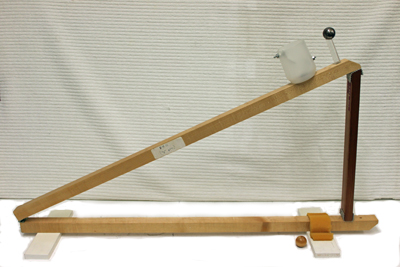Objective:
– To show that the free end of a stick hinged at the opposite end can fall with an acceleration greater than “g”, the acceleration due to gravity.
Apparatus:
- hinged board assembly
- steel sphere
- wooden sphere
- prop

Introduction:
When the prop is pulled free the upper hinged board and the sphere start to fall under the influence of gravity. The free end of the hinged board will fall faster than “g” while the sphere has an acceleration = “g”. The sphere lands in the cup.
Method:
Set up the apparatus as shown in the above diagram taking care to place the prop as described. The end of the “tee” has been cut at an angle such that the sphere will sit in place after the upper hinged board has been propped up.
Pull the prop cleanly away from the assembly. The sphere should land in, and stay in the catch cup. It is recommended that an instructor try the procedure before demonstrating in front of a class.
Incorrect placement and/or pulling free of the prop can cause the ball to miss the cup(or the cup to miss the ball depending on your point of view).
The baffles in the cup make the removal of the sphere a bit awkward. One simple method of removing the sphere is to simply pick up the apparatus and tip the sphere out of the cup into your free hand.
Spheres of different masses are supplied to show that the mass of the falling body is not a relevant factor.
The baffles in the catch cup are intended to stop the sphere from bouncing out of the cup as the upper hinged board claps against the lower board.
Falling Faster Than “g”
– Video Created at Harvard Natural Sciences Lecture Demonstrations